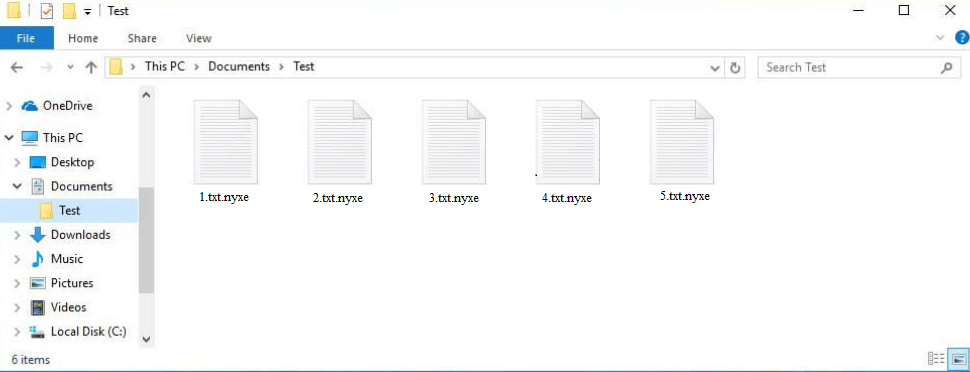Remove Nyxe ransomware
Nyxe ransomware is malware that targets personal files and encrypts them. The ransomware does not appear to be fully functional so it’s likely still in development. Nonetheless, users can infect their computers with it, and if no backup is available, they will permanently lose access to their files. Users who have backups can recover files as soon as they remove Nyxe ransomware from their computer. If your computer is infected, keep in mind that there is no way to contact the cybercriminals so there is no other way to recover your files.
When ransomware infiltrates a computer, it immediately starts encrypting files. The primary targets are personal files that users value most, including documents, photos, videos, and images. Encrypted files can be easily recognized due to the new extensions added to their names. This particular ransomware appends the extension .nyxe, so, for example, a file named text.txt would become text.txt.nyxe if encrypted.
Additionally, the ransomware drops a file named Decryption Instructions.txt which serves as a ransom note. This note contains limited information, simply stating that files have been encrypted and can only be recovered if the user pays a ransom. It does not specify the amount that victims need to pay, nor does it provide any means for victims to contact the cybercriminals, making it impossible to obtain a decryptor.
The ransom note dropped by Nyxe ransomware is below:
———- Nyxe Ransomware ———-
Your files have been encrypted using Nyxe Ransomware!
They can only be decrypted by paying us a ransom in cryptocurrency.Encrypted files have the .nyxe extension.
IMPORTANT: Do not modify or rename encrypted files, as they may become unrecoverable.When Send, Files will be decrypted automatically and ransom will delete itself
———- Nyxe Ransomware ———-
While it’s impossible to pay the ransom in this case, if it was, it would not be recommended. Victims need to remember that they are dealing with cybercriminals who have no obligation to assist them after receiving payment. There are no guarantees that victims will get a decryption key after paying. Unfortunately, many victims have previously paid ransoms only to receive non-functioning decryption tools or nothing at all.
Users who have backups can begin recovering their files as soon as they remove Nyxe ransomware from their computers. It is highly recommended to use an anti-malware program, as this is a sophisticated infection, even if it’s not finished. Once the ransomware has been removed, it is safe to connect to a backup. For users without backups, the only option is to back up the encrypted files and wait for a free Nyxe ransomware decryptor to become available. However, it’s important to note that there is no guarantee that a free Nyxe ransomware decryptor will be released.
How does ransomware infect computers?
Malicious actors use various methods to distribute ransomware, including torrents, email attachments, and malicious links or ads. Users who engage in risky online behavior are more likely to infect their computers. To avoid malware infections, we strongly recommend developing better browsing habits and understanding common malware distribution methods.
Emails are a frequent method for distributing malware. These emails may be disguised as parcel delivery notifications or order confirmations. To capture users’ attention and create a sense of urgency, they often mention large sums of money or expensive purchases, encouraging users to open the attachments without double-checking. However, malicious emails can usually be identified if users take the time to inspect all unsolicited emails they receive. Malicious emails often contain obvious spelling and grammar mistakes, which legitimate emails typically do not have. Additionally, such emails usually address recipients with generic words like “User,” “Member,” or “Customer.” In contrast, most companies personalize their correspondence by using recipients’ names. Malicious actors typically do not have access to personal information, forcing them to use these generic terms.
When emails target specific individuals, the emails will be much more sophisticated. These targeted emails often lack the usual signs of maliciousness, address the recipient by name, and include credible information that adds authenticity. Therefore, it is always advisable to avoid opening unsolicited email attachments unless they have first been scanned with anti-virus software or checked using VirusTotal.
Torrents are another popular method for distributing malware. Torrent sites are usually poorly moderated, which allows malicious actors to upload files that contain malware. Torrents for entertainment content, such as movies, TV series, and video games, are particularly like to have malware in them. By pirating copyrighted content, users are not only essentially stealing but also jeopardizing their computers and data.
How to remove Nyxe ransomware
Ransomware is a highly sophisticated type of malware, and it is essential to remove it using a professional program. Attempting to manually remove Nyxe ransomware could cause further damage to your device. Therefore, it is strongly recommended to use an anti-virus program for this process. Once the ransomware has been completely removed and is no longer detected, you can safely connect to your backup and start recovering your files. However, be aware that if ransomware is still present when you connect to your backup, any backed-up files could also become encrypted.
Site Disclaimer
WiperSoft.com is not sponsored, affiliated, linked to or owned by malware developers or distributors that are referred to in this article. The article does NOT endorse or promote malicious programs. The intention behind it is to present useful information that will help users to detect and eliminate malware from their computer by using WiperSoft and/or the manual removal guide.
The article should only be used for educational purposes. If you follow the instructions provided in the article, you agree to be bound by this disclaimer. We do not guarantee that the article will aid you in completely removing the malware from your PC. Malicious programs are constantly developing, which is why it is not always easy or possible to clean the computer by using only the manual removal guide.

